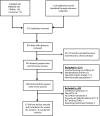Effects of Community-Based Health Worker Interventions to Improve Chronic Disease Management and Care Among Vulnerable Populations: A Systematic Review
- PMID: 26890177
- PMCID: PMC4785041
- DOI: 10.2105/AJPH.2015.302987
Effects of Community-Based Health Worker Interventions to Improve Chronic Disease Management and Care Among Vulnerable Populations: A Systematic Review
Abstract
Background: Community-based health workers (CBHWs) are frontline public health workers who are trusted members of the community they serve. Recently, considerable attention has been drawn to CBHWs in promoting healthy behaviors and health outcomes among vulnerable populations who often face health inequities.
Objectives: We performed a systematic review to synthesize evidence concerning the types of CBHW interventions, the qualification and characteristics of CBHWs, and patient outcomes and cost-effectiveness of such interventions in vulnerable populations with chronic, noncommunicable conditions.
Search methods: We undertook 4 electronic database searches-PubMed, EMBASE, Cumulative Index to Nursing and Allied Health Literature, and Cochrane-and hand searched reference collections to identify randomized controlled trials published in English before August 2014.
Selection: We screened a total of 934 unique citations initially for titles and abstracts. Two reviewers then independently evaluated 166 full-text articles that were passed onto review processes. Sixty-one studies and 6 companion articles (e.g., cost-effectiveness analysis) met eligibility criteria for inclusion.
Data collection and analysis: Four trained research assistants extracted data by using a standardized data extraction form developed by the authors. Subsequently, an independent research assistant reviewed extracted data to check accuracy. Discrepancies were resolved through discussions among the study team members. Each study was evaluated for its quality by 2 research assistants who extracted relevant study information. Interrater agreement rates ranged from 61% to 91% (average 86%). Any discrepancies in terms of quality rating were resolved through team discussions.
Main results: All but 4 studies were conducted in the United States. The 2 most common areas for CBHW interventions were cancer prevention (n = 30) and cardiovascular disease risk reduction (n = 26). The roles assumed by CBHWs included health education (n = 48), counseling (n = 36), navigation assistance (n = 21), case management (n = 4), social services (n = 7), and social support (n = 18). Fifty-three studies provided information regarding CBHW training, yet CBHW competency evaluation (n = 9) and supervision procedures (n = 24) were largely underreported. The length and duration of CBHW training ranged from 4 hours to 240 hours with an average of 41.3 hours (median: 16.5 hours) in 24 studies that reported length of training. Eight studies reported the frequency of supervision, which ranged from weekly to monthly. There was a trend toward improvements in cancer prevention (n = 21) and cardiovascular risk reduction (n = 16). Eight articles documented cost analyses and found that integrating CBHWs into the health care delivery system was associated with cost-effective and sustainable care.
Conclusions: Interventions by CBHWs appear to be effective when compared with alternatives and also cost-effective for certain health conditions, particularly when partnering with low-income, underserved, and racial and ethnic minority communities. Future research is warranted to fully incorporate CBHWs into the health care system to promote noncommunicable health outcomes among vulnerable populations.
Figures
Comment in
-
Kim et al. Respond.Am J Public Health. 2016 Aug;106(8):e10-1. doi: 10.2105/AJPH.2016.303276. Am J Public Health. 2016. PMID: 27400358 Free PMC article. No abstract available.
-
The Terminology of Community Health Workers.Am J Public Health. 2016 Aug;106(8):e10. doi: 10.2105/AJPH.2016.303248. Am J Public Health. 2016. PMID: 27400359 Free PMC article. No abstract available.
References
-
- Merriam-Webster Dictionary. Vulnerable. Available at: h ttp://www.merriam-webster.com/dictionary/vulnerable?show=0&t=1377802131. Accessed November 25, 2014.
-
- Centers for Disease Control and Prevention. Minority health: other at risk populations. 2014. Available at: http://www.cdc.gov/minorityhealth/populations/atrisk.html. Accessed November 25, 2014.
-
- Institute of Medicine. Unequal Treatment: Confronting Racial and Ethnic Disparities in Health Care. Washington, DC: National Academies Press; 2002. - PubMed
-
- Gallup. In US, uninsured rate holds at 13.4%. 2014. Available at: http://www.gallup.com/poll/178100/uninsured-rate-holds.aspx. Accessed January 10, 2015.
-
- Gallup. Cost still a barrier between Americans and medical care. Available at: http://www.gallup.com/poll/179774/cost-barrier-americans-medical-care.aspx. 2014. Accessed January 10, 2015.
Publication types
MeSH terms
Grants and funding
LinkOut - more resources
Full Text Sources
Other Literature Sources
Medical
Molecular Biology Databases
Miscellaneous


